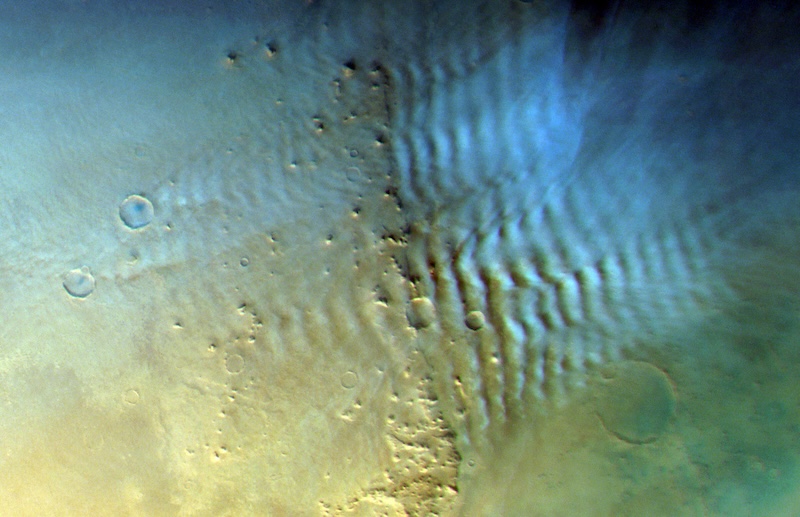- Mars has many kinds of clouds despite its very thin atmosphere. They can be composed of of water, carbon dioxide or dust.
- A new Cloud Atlas of Mars has been released by researchers in Europe. It contains images of Martian clouds from the Mars Express orbiter from the past 20 years.
- Some of the clouds are similar to earthly clouds, while others are unique to Mars.
Cloudspotting on Mars
Despite its thin atmosphere, Mars has a wide variety of clouds floating in its chilly air. And now there’s a new database where you can see images of clouds and storms from over 20 years. Researchers with the German Aerospace Centre (DLR) created the catalog – called the HRSC Cloud Atlas – and presented it last week at the Europlanet Science Congress (EPSC) 2024 in Berlin, Germany. The Europlanet Society said on September 10, 2024, the browsable atlas contains images from the European Space Agency’s Mars Express orbiter going back to 2003.
The researchers also note that a published paper is being prepared to go along with the atlas itself.
The Cloud Atlas of Mars
The new atlas contains images taken by Mars Express’ High Resolution Stereo Camera (HRSC). Mars Express has been orbiting Mars since 2003 and is still going strong. It may seem surprising that Mars even has clouds and storms, since its atmosphere is so thin. It’s less than 1% that of Earth’s at sea level.
But it does! In fact, there are a wide variety of cloud and storm phenomena. Water and carbon dioxide ice crystals, and dust particles, can help clouds form. And Mars is famous for its giant dust storms.
See some examples below, and you can find more in the HRSC Cloud Atlas MS Excel spreadsheet.
Cloud streets
Some cloud formations are similar to those on Earth, but others are unique to Mars. Daniela Tirsch at the German Aerospace Centre said:
Clouds on Mars are just as diverse and fascinating as those we see in our skies on Earth, with some features unique to the red planet. One of my favorite phenomena are the beautiful cloud streets, linear rows of fleecy clouds that develop around the huge volcanic Tharsis rise and the northern lowlands in northern spring and summer. While they resemble cumulus clouds on Earth, they are formed under different atmospheric conditions. We also see impressive dust clouds that can spread hundreds of kilometers, a phenomena we luckily don’t experience on Earth.


Gravity clouds, lee waves, twilight clouds and cirrus clouds
Gravity wave clouds occur both on Earth and Mars. On Mars, they develop at mid-latitudes in both hemispheres. In southern winter, they can occur over the Tharsis volcanic plateau. This is where the largest volcanoes are on Mars, including Olympus Mons.
Lee wave clouds, or wave clouds, are a type of gravity cloud and have a distinct “rippled” appearance about them. They form in atmospheric lee waves on the leeward, or downwind, side of mountains, ridges or other obstacles. The shape of the obstacle determines what the specific appearance of the clouds will be.
Twilight clouds, also known as noctilucent or night-shining clouds, tend to appear in the early morning, and at any location or time of year.
Plus, in addition to observations from orbit, Mars landers and rovers have also seen clouds. Typically thin and cirrus-like, if you were standing on Mars and looking up at them, they’d look the same as on Earth. The Perseverance rover has even seen noctilucent clouds.

Dust clouds
Clouds on Mars can be composed of either water or carbon dioxide. But Mars is also a very dusty place, so dust cloud are also common. Indeed, the planet is well-known for its huge dust storms. They can sometimes spread across the entire planet. Upwelling events can also leave blobs of dust hanging in the atmosphere. Occasionally, winds are stronger than usual due to differences in air temperature and pressure. This can lift enormous amounts of dust into the air, more than ever happens on Earth.
Also, long clouds can sometimes be seen flowing away from the peaks of volcanoes. It can look like the volcano is erupting, although it actually isn’t. Mars’ volcanoes have been dormant or dead for millions to billions of years.
Some dust storms also look like huge spirals or cyclones. This happens every year near the Martian North Pole.
Bottom line: Want to do some cloudspotting on Mars? Researchers in Germany have created the new Cloud Atlas of Mars, with 20 years of images from the Mars Express orbiter.
Via Europlanet Society
See the HRSC Cloud Atlas of Mars
Read more: A Martian cloud reveals its secrets
Read more: Cloudspotting on Mars: You can help